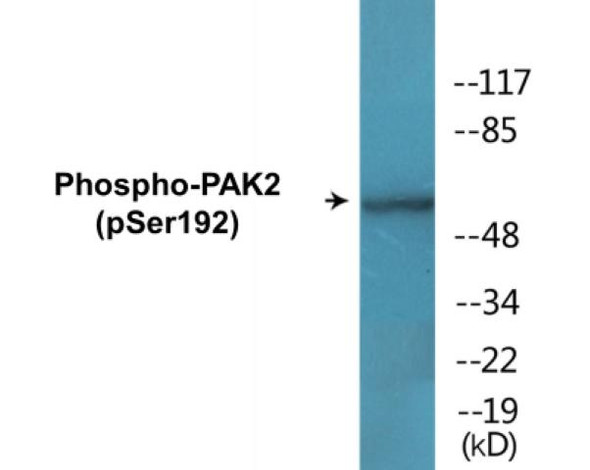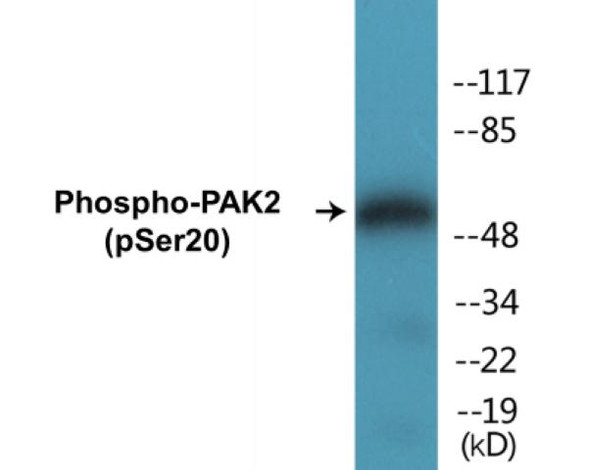Description
PAK2 Colorimetric Cell-Based ELISA Kit
The PAK2 Colorimetric Cell-Based ELISA Kit is a powerful tool for researchers looking to accurately quantify the levels of PAK2 (p21-activated kinase 2) in cell lysates and tissue homogenates. This kit offers high sensitivity and specificity, allowing for precise and reliable detection of PAK2 levels, making it ideal for a variety of research applications.PAK2 is a key signaling molecule involved in cell growth, survival, and migration, making it a critical player in various cellular processes and diseases such as cancer, neurodegenerative disorders, and inflammatory diseases.
By studying PAK2 levels, researchers can gain valuable insights into these conditions and potentially develop new therapeutic approaches.With its user-friendly protocol and comprehensive components, the PAK2 Colorimetric Cell-Based ELISA Kit is a valuable tool for researchers seeking to explore the role of PAK2 in health and disease. Get accurate and reproducible results with this top-of-the-line kit from Assay Genie.
| Product Name: | PAK2 Colorimetric Cell-Based ELISA Kit |
| Product Code: | CBCAB00799 |
| ELISA Type: | Cell-Based |
| Target: | PAK2 |
| Reactivity: | Human, Mouse, Rat |
| Dynamic Range: | > 5000 Cells |
| Detection Method: | Colorimetric 450 nmStorage/Stability:4°C/6 Months |
| Format: | 96-Well Microplate |
The PAK2 Colorimetric Cell-Based ELISA Kit is a convenient, lysate-free, high throughput and sensitive assay kit that can detect PAK2 protein expression profile in cells. The kit can be used for measuring the relative amounts of PAK2 in cultured cells as well as screening for the effects that various treatments, inhibitors (ie siRNA or chemicals), or activators have on PAK2.
Qualitative determination of PAK2 concentration is achieved by an indirect ELISA format. In essence, PAK2 is captured by PAK2-specific primary antibodies while the HRP-conjugated secondary antibodies bind the Fc region of the primary antibody. Through this binding, the HRP enzyme conjugated to the secondary antibody can catalyze a colorimetric reaction upon substrate addition. Due to the qualitative nature of the Cell-Based ELISA, multiple normalization methods are needed:
| 1. | A monoclonal antibody specific for human GAPDH is included to serve as an internal positive control in normalizing the target absorbance values. |
| 2. | Following the colorimetric measurement of HRP activity via substrate addition, the Crystal Violet whole-cell staining method may be used to determine cell density. After staining, the results can be analysed by normalizing the absorbance values to cell amounts, by which the plating difference can be adjusted. |
| Database Information: | Gene ID: 5062, UniProt ID: Q13177, OMIM: 605022, Unigene: Hs.518530 |
| Gene Symbol: | PAK2 |
| Sub Type: | None |
| UniProt Protein Function: | PAK2: a protein kinase of the STE20 family. Critical effector linking RhoGTPases to cytoskeleton reorganization and nuclear signaling. Activated by proteolytic cleavage during caspase-mediated apoptosis, and may play a role in regulating the apoptotic events in the dying cell. |
| UniProt Protein Details: | Protein type:Protein kinase, Ser/Thr (non-receptor); EC 2.7.11.1; Protein kinase, STE; Kinase, protein; STE group; STE20 family; PAKA subfamily Chromosomal Location of Human Ortholog: 3q29 Cellular Component: cytoplasm; cytosol; nucleoplasm; perinuclear region of cytoplasm; plasma membrane Molecular Function:ATP binding; identical protein binding; protein binding; protein kinase activity; protein kinase binding; protein serine/threonine kinase activity; protein tyrosine kinase activator activity; Rac GTPase binding Biological Process: actin cytoskeleton organization and biogenesis; apoptosis; axon guidance; cell migration; cell structure disassembly during apoptosis; innate immune response; negative regulation of apoptosis; negative regulation of protein kinase activity; peptidyl-serine phosphorylation; phosphorylation; positive regulation of peptidyl-tyrosine phosphorylation; programmed cell death; protein amino acid autophosphorylation; protein amino acid phosphorylation; regulation of apoptosis; regulation of defense response to virus by virus; regulation of growth; regulation of MAPKKK cascade; regulation of mitotic cell cycle; Rho protein signal transduction; signal transduction; small GTPase mediated signal transduction; stimulatory C-type lectin receptor signaling pathway; stress-activated protein kinase signaling pathway; T cell costimulation; T cell receptor signaling pathway; vascular endothelial growth factor receptor signaling pathway; viral reproduction |
| NCBI Summary: | The p21 activated kinases (PAK) are critical effectors that link Rho GTPases to cytoskeleton reorganization and nuclear signaling. The PAK proteins are a family of serine/threonine kinases that serve as targets for the small GTP binding proteins, CDC42 and RAC1, and have been implicated in a wide range of biological activities. The protein encoded by this gene is activated by proteolytic cleavage during caspase-mediated apoptosis, and may play a role in regulating the apoptotic events in the dying cell. [provided by RefSeq, Jul 2008] |
| UniProt Code: | Q13177 |
| NCBI GenInfo Identifier: | 143811432 |
| NCBI Gene ID: | 5062 |
| NCBI Accession: | Q13177.3 |
| UniProt Secondary Accession: | Q13177,Q13154, Q6ISC3, |
| UniProt Related Accession: | Q13177 |
| Molecular Weight: | |
| NCBI Full Name: | Serine/threonine-protein kinase PAK 2 |
| NCBI Synonym Full Names: | p21 protein (Cdc42/Rac)-activated kinase 2 |
| NCBI Official Symbol: | PAK2 |
| NCBI Official Synonym Symbols: | PAK65; PAKgamma |
| NCBI Protein Information: | serine/threonine-protein kinase PAK 2 |
| UniProt Protein Name: | Serine/threonine-protein kinase PAK 2 |
| UniProt Synonym Protein Names: | Gamma-PAK; PAK65; S6/H4 kinase; p21-activated kinase 2; PAK-2 |
| Protein Family: | Serine/threonine-protein kinase |
| UniProt Gene Name: | PAK2 |
| UniProt Entry Name: | PAK2_HUMAN |
| Component | Quantity |
| 96-Well Cell Culture Clear-Bottom Microplate | 2 plates |
| 10X TBS | 24 mL |
| Quenching Buffer | 24 mL |
| Blocking Buffer | 50 mL |
| 15X Wash Buffer | 50 mL |
| Primary Antibody Diluent | 12 mL |
| 100x Anti-Phospho Target Antibody | 60 µL |
| 100x Anti-Target Antibody | 60 µL |
| Anti-GAPDH Antibody | 60 µL |
| HRP-Conjugated Anti-Rabbit IgG Antibody | 12 mL |
| HRP-Conjugated Anti-Mouse IgG Antibody | 12 mL |
| SDS Solution | 12 mL |
| Stop Solution | 24 mL |
| Ready-to-Use Substrate | 12 mL |
| Crystal Violet Solution | 12 mL |
| Adhesive Plate Seals | 2 seals |
The following materials and/or equipment are NOT provided in this kit but are necessary to successfully conduct the experiment:
- Microplate reader able to measure absorbance at 450 nm and/or 595 nm for Crystal Violet Cell Staining (Optional)
- Micropipettes with capability of measuring volumes ranging from 1 µL to 1 ml
- 37% formaldehyde (Sigma Cat# F-8775) or formaldehyde from other sources
- Squirt bottle, manifold dispenser, multichannel pipette reservoir or automated microplate washer
- Graph paper or computer software capable of generating or displaying logarithmic functions
- Absorbent papers or vacuum aspirator
- Test tubes or microfuge tubes capable of storing ≥1 ml
- Poly-L-Lysine (Sigma Cat# P4832 for suspension cells)
- Orbital shaker (optional)
- Deionized or sterile water
*Note: Protocols are specific to each batch/lot. For the correct instructions please follow the protocol included in your kit.
| Step | Procedure |
| 1. | Seed 200 µL of 20,000 adherent cells in culture medium in each well of a 96-well plate. The plates included in the kit are sterile and treated for cell culture. For suspension cells and loosely attached cells, coat the plates with 100 µL of 10 µg/ml Poly-L-Lysine (not included) to each well of a 96-well plate for 30 minutes at 37°C prior to adding cells. |
| 2. | Incubate the cells for overnight at 37°C, 5% CO2. |
| 3. | Treat the cells as desired. |
| 4. | Remove the cell culture medium and rinse with 200 µL of 1x TBS, twice. |
| 5. | Fix the cells by incubating with 100 µL of Fixing Solution for 20 minutes at room temperature. The 4% formaldehyde is used for adherent cells and 8% formaldehyde is used for suspension cells and loosely attached cells. |
| 6. | Remove the Fixing Solution and wash the plate 3 times with 200 µL 1x Wash Buffer for five minutes each time with gentle shaking on the orbital shaker. The plate can be stored at 4°C for a week. |
| 7. | Add 100 µL of Quenching Buffer and incubate for 20 minutes at room temperature. |
| 8. | Wash the plate 3 times with 1x Wash Buffer for 5 minutes each time. |
| 9. | Add 200 µL of Blocking Buffer and incubate for 1 hour at room temperature. |
| 10. | Wash 3 times with 200 µL of 1x Wash Buffer for 5 minutes each time. |
| 11. | Add 50 µL of 1x primary antibodies (Anti-PAK2 Antibody and/or Anti-GAPDH Antibody) to the corresponding wells, cover with Parafilm and incubate for 16 hours (overnight) at 4°C. If the target expression is known to be high, incubate for 2 hours at room temperature. |
| 12. | Wash 3 times with 200 µL of 1x Wash Buffer for 5 minutes each time. |
| 13. | Add 50 µL of 1x secondary antibodies (HRP-Conjugated AntiRabbit IgG Antibody or HRP-Conjugated Anti-Mouse IgG Antibody) to corresponding wells and incubate for 1.5 hours at room temperature. |
| 14. | Wash 3 times with 200 µL of 1x Wash Buffer for 5 minutes each time. |
| 15. | Add 50 µL of Ready-to-Use Substrate to each well and incubate for 30 minutes at room temperature in the dark. |
| 16. | Add 50 µL of Stop Solution to each well and read OD at 450 nm immediately using the microplate reader. |
(Additional Crystal Violet staining may be performed if desired – details of this may be found in the kit technical manual.)






